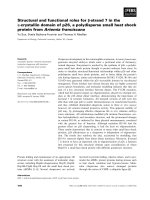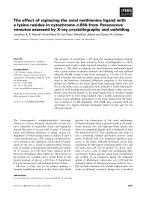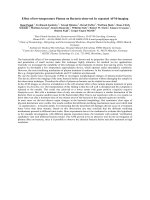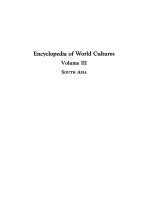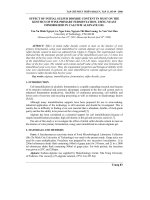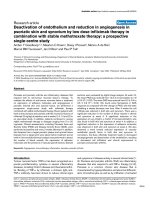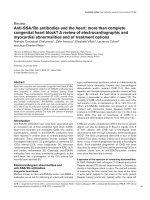Effect of age of seedling and number of seedlings per hill on growth and yield of low land rice cultivation in ASIA – A review
Bạn đang xem bản rút gọn của tài liệu. Xem và tải ngay bản đầy đủ của tài liệu tại đây (219.67 KB, 10 trang )
Int.J.Curr.Microbiol.App.Sci (2018) 7(6): 3751-3760
International Journal of Current Microbiology and Applied Sciences
ISSN: 2319-7706 Volume 7 Number 06 (2018)
Journal homepage:
Review Article
/>
Effect of Age of Seedling and Number of Seedlings per Hill on Growth and
Yield of Low land Rice Cultivation in Asia – A Review
G. N. Gurjar1*, Sanjay Swami1 and N. K. Meena2
1
School of Natural Resource Management, Central Agricultural University,
CPGS, Umiam, Meghalaya-793103, India
2
School of Social Sciences, CPGS CAU, Umiam, Meghalaya, India
*Corresponding author
ABSTRACT
Keywords
Age, Seedling,
Non-monetary
input, Eco-friendly,
Cost effective
Article Info
Accepted:
28 April 2018
Available Online:
10 June 2018
Among the various agro-techniques uprooting aged seedlings and ideal number of
seedling/hill are the two supreme important agronomic practices for attainment the higher
grain yield of rice, under both sufficient and limited resource conditions. Number of
seedling per hill theatres a most important role in relative to maximise grain yield of rice
and also for communal rice varieties. If fewer number of seedlings per hill is used, the
probable yield cannot be realize, If extra seedlings is used it might not be cost effective. It
becomes imperative therefore to find out the optimum number of seedlings required per
hill for producing high number of panicles, number of effective tillers per hill at harvest,
number of filled grains per panicle, optimum size and shape of grains and ultimately
higher yield of high quality and quantity both. The suitable time of nursery preparation and
transplanting of seedlings at early stage is most important to get good results from the crop
and also the optimum number of seedlings according to status of soil and management
practices is one of the non-monetary inputs for farmers especially in resource limited
conditions. Such techniques of crop production not only adopted in developing countries
but also in developed countries because it has been reported from across the globe about
how much such techniques are important to increase agricultural production along with
cost effective, environment friendly and conserve natural resource too.
Introduction
Rice is the staple food crop of India providing
major source of the food energy for more than
half of the world population. It is grown in
155 M ha area at global levels and around 45
M ha area in India. India occupies first place
in area of rice in the world and second
position in production. Rice is grown in most
of the states across the country under different
agro techniques. Rice play a major role in
Indian agriculture. It provides 43 % of total
calories requirement for more than 70 % of
population living in hilly and plain regions of
the country Anonymous (2006). In India, rice
is grown under various climatic condition and
different techniques of crop production in
hilly area of north east India to plain area of
Punjab, Haryana, Rajasthan, Uttar Pradesh
etc.
The saying “Rice is life” is the most
adoptable for country like India as rice crop
has been playing a vital part to our national
3751
Int.J.Curr.Microbiol.App.Sci (2018) 7(6): 3751-3760
food security. Rice productivity and
production will be needed to increase
accordingly increasing food demand and
population. The introduction and cultivation
of fertilizer responsive and dwarf varieties
cause the increased food grain production in
past 70th century known as „Green
Revolution‟. But now a days those techniques
are no longer suitable to increase in potential
yield and productivity in both area and time
dimension under changing climate scenario
and their yield is at plateau. So, we need
another techniques of crop production those
are environmentally sound, cost effective and
requires low inputs such as number of
seedlings per hill and age of transplanting
seedlings. Because such techniques are cost
effective i.e. farmers can easily adopt without
changing in input requirement. What we have
to do is to change in transplanting time and
number of transplanted seedlings without
interfering in other management and cultural
practices. This techniques is most famous
because if we suggest farmers to use hygienic
techniques some of them may be but not all
because of limited resources and credit
problems as well as other factors like climate,
topography and input use supply and plant
management factors.
Effect of age of seedling on the growth and
yield of rice
Effect of age of seedling
Rajendran and Ganesa (2014) found that the
effect of age of seedlings at transplanting is
considered for influencing grain yield in
water scarce rice production system, primarily
by laying the foundation for determining the
number of panicle at harvest. Seedling age at
transplanting is an important factor for
uniform stand of rice and its growth and yield.
Further Naidu et al., (2013) reported that in
combination of four different ages of
seedlings (8, 12, 16 and 20 days old) and four
planting pattern (20x20 cm, 25x25 cm, 30x30
cm and 35x35 cm) on rice. Transplanting of
12 days old seedling resulted in highest plant
height, grain yield, grain protein and NPK
uptake. Ali et al., (2013) further observed the
effect of seedlings age on tillering behaviour,
growth dynamics, yield and yield contributing
characters of BRRI dhan 28 and found that 15
days old seedlings provided greater ability to
tiller production, dry matter accumulation and
more leaf area, more effective tiller/hill, filled
grains/panicle,1000 grain weight and finally
grain yield and observed that 30 day old
seedlings when transplanted at a spacing of 20
cm x15 cm. from 7 August to 7 September
gave more number of tiller/ m2, panicles/ m2
and grains / panicle which resulted in higher
grain yield. Thus, fine rice basmati PNR and
Basmati –D were most suitable to obtain
higher grain yield when planted within 17-21
August (Mannan et al.,2009).(El-rewainy et
al.,2007) also observed that the transplanting
of youngest seedling (25 days old) produced
highest significant value of leaf area (cm2)
and total dry weight (g/ hill) as well as grain
and most of its component of both cultivars
(Sakha 101and sakha 102), while the 30 days
old seedling gives the tallest plant. Further
explained that planting of four weeks old
seedlings recorded higher number of ripened
grains than five and six week old seedlings
during kharif season (Sahoo and Rout, 2004).
Rajesh and Thanunathan (2003) observed that
planting of 40 days old seedling with 2
seedlings/ hill at a spacing of 20x15cm was
optimum in increasing the yield of
Kambanchamba rice. The effect of seedling
age and number of seedling/ hill on rice
growth and yield. The results revealed that
seedling of 25- to- 35 days old produced
significantly higher number of tillers and
productive tiller/hill, paddy and straw yields
compared with 55-days old seedlings. In
another experiment also the transplanting of 2
and 3 seedlings/hill of 35 days old gave more
promising results (Ashraf et al., 1999) and
3752
Int.J.Curr.Microbiol.App.Sci (2018) 7(6): 3751-3760
Further reported that transplanting of 35-days
old seedlings with 4-5 or 6-7 seedlings/hill of
medium duration were gave significantly the
highest grain yield than 25- or 45-day old
seedlings (Channabasappa et al., (1997).
Effect of number of seedling/hill on growth
and yield of rice
Effect of number of seedlings on growth
characters
Chauhan (2005) reported that transplanting of
3 seedlings per hill recorded maximum plant
height (97.83 cm) and dry matter
accumulation per hill (19.08g) as compared to
1 and 2 seedlings per hill. Also found that
plant height did not influenced significantly
due to number of seedlings (1 and 2 seedlings
per hill) in rice hybrid „III you 98‟ under
agro-ecological situations of China(Zhang et
al.,2004).Pariyani and Naik (2004) reported
from Jabalpur, planting of 1 or 2seedlings per
hill did not showed significant difference on
plant height with rice hybrids „PA 6201‟ and
„PAC 801‟.Nayak et al., (2003) laid down an
experiment at Bhubaneshwar on hybrid rice
„PA 6201‟ and revealed that total tillers,
effective tillers per hill, leaf area index and
dry matter accumulation per clump were
significantly more with planted 2 seedlings
per hill than planted with 1 seedlings per hill.
Plant height recorded significantly more with
1 seedling per hill than the 2 seedlings per
hill. Dongarwar et al., (2002) studied the
response of number of seedlings per hill on
hybrid rice „Sahyadri‟ and observe that
transplanting of 1 seedling per hill was at par
with transplanting of 2 seedlings per hill in
respect of plant height and total tillers per m2.
Verma et al., (2002) carried out an
investigation at Raipur on hybrid rice „PA
6201‟ and stated that crop planted with 3
seedlings per hill produced higher number of
productive tillers than those planted with 1 or
2 seedlings per hill. Molla (2001) conducted a
field experiment at West Bengal with rice
hybrids „PA 6201‟ and „CNRH 3‟, revealed
that 2 seedlings per hill produced significantly
higher number of tillers per m2 as compared
to 1 seedlings per hill. Shrirame et al., (2000)
found that 2 seedlings per hill gave
significantly higher number of tillers per hill
than 1 and 3 seedlings per hill. Plant height
and leaf area index were not affected
significantly by number of seedlings per hill.
Channabasappa et al., (1998) reported from
Karnataka that plant height was not affected
significantly due to varying number of
seedlings per hill but the tallest plants were
recorded with 4-5 seedlings per hill as
compared to 2-3 and 6-7 seedlings per hill.
Srivatav and Tripathi (1998) a field
experiment was conducted at Raipur with rice
hybrid „PA 6201‟ and cv. „R 320-300‟ and
revealed that crop transplanted with 2
seedlings per hill recorded significantly more
effective tillers per m2 (316) as compared to
transplanted with 1 (308) and 3 seedlings per
hill (309).
Banik et al., (1997) reported that among the
different number of seedlings per hill, 4
seedlings per hill recorded maximum plant
height, dry matter production and number of
tillers per hill and leaf area index than 2, 6
and 8 seedlings per hill. Srinivasulu (1997)
conducted a field experiment with two
hybrids „APHR 1‟ and „APHR 2‟ and one cv.
„Chaitanya‟ at Bapatla and concluded that the
crop transplanted with 2 seedlings per hill
produced significantly higher productive
tillers per m2 (292) than the crop transplanted
with 1 seedling per hill. Gupta (1996) found
that transplanting of 1 seedling per hill
significantly increased plant height, than the
higher number of seedlings per hill. Cai et al.,
(1991) found that the tiller number also
increased with increased in seedlings number
from 1 to 3 per hill. Shah et al., (1991) from a
field experiment with cv „K 39‟ using 3, 4, 5
and 6 seedlings per hill found that plant
3753
Int.J.Curr.Microbiol.App.Sci (2018) 7(6): 3751-3760
height increased with decreased seedlings per
hill, on the other hand they were also found
that tiller number increased with increased
number of seedlings per hill from 3 to 6.
Zhang and Hung (1990) reported from China,
that there was significant increase in the plant
height due to increase in number of seedlings
from 1 to 5 per hill. 5 seedlings per hill
recorded significantly more plant height (84.4
cm) than the 1 seedling per hill (79.0cm), 2
seedlings per hill (82.2cm), 3 seedlings per
hill (81.8 cm) and 4 seedlings (80.4cm) per
hill. Budhar et al., (1989) observed that there
was no significant difference in plant height
with 2 or 4 seedlings per hill. Das et al.,
(1988) observed that increasing the number of
seedlings per hill increased growth characters
like plant height, dry matter production per
hill, leaf area index and functional leaves per
hill with 5 seedlings per hill and also Siddhu
et al., (1988) found that rice crop transplanted
with 2 seedlings per hill produced higher
number of tillers per hill, number of leaves
per hill and dry matter production per m2 as
compared to 1 seedling per hill. Shah et al.,
(1987) number of seedlings per hill markedly
influenced the plant height of rice cv. „K 39‟.
3 seedlings per hill recorded more height
(95.6 cm) than 6 seedlings per hill (92.6cm).
Baird et al., (1985) also reported that tillers
density increased significantly with increasing
seedling rate and established plant stand
throughout the growing season. Reddy and
Mitra (1984) observed that tiller number per
m2 decreased with more than 2 seedlings per
hill when planted.
Effect of number of seedlings per hill on
yield and yield contributing characters
Thawait et al., (2014) observed that
transplanting of 2-3 seedling/hill in the
spacing of 25 cm x 25 cm recorded
significantly highest plant height (129.64),
number of tillers (15.70 tillers/hill), dry
matter accumulation (102.65 g/hill) and yield
attributing characters along with highest grain
yield (38.20 q/ha) and straw yield
(77.91q/ha). Further Ehsanullah et al., (2012)
observed the effect of seedlings density per
hill have a strong influence on rice growth
and grain yield due to competitive effects
both on the vegetative and reproductive
development. Panicle length, number of
branches per panicle and kernels per panicle
remained unaffected at varying levels of rice
seedlings per hill. 2, 3 and 4 seedlings/hill
resulted in maximum rice kernel yield and
harvest index due to enhanced number of
panicle bearing tillers and 1000- kernel
weight. Ahmad and Hasanuzzaman (2012)
observed that the highest grain yield (497
g/m2) were observed in the treatment having
combination of two seedling/hill. Roshan et
al., (2011) observed that the highest grain
yield (4073.38 kg/ ha) was obtained from
plant spacing 15 x 15 cm and number of 5
seedling/ hill as compare to the other plant
spacing like 20x20 cm, 25x25cm and 1, 3, 7
number of seedling / hill.
Naser et al., (2011) conducted experiments
with three plant spacing (15 x 15 cm: 20 x
20cm: 25 x 25cm) and four different
seedlings/hill (1 seedling/hill: 3 seedlings/hill:
5 seedlings/hill: 7 seedlings/hill) during 2008
in Iran. The result revealed that higher grain
yield with 3921.67 kg/ha was obtained from
transplanting
of
5
seedlings/hill.
Hasanuzzman et al., (2009) the results
revealed that both the plant spacing and no. of
seedlings/hill showed a significant effect on
the tillering and dry matter yield of
transplanted rice. At all the growth stages
wider row spacing (25 cm x 20 cm) and
higher number of seedlings/ hill (3 and 4)
showed maximum tillering. Islam et al.,
(2008) observed the effect of nitrogen (N) and
number of seedlings/hill on the yield and
yield component of transplanted aman rice cv.
BRRI dhan 33. Transplanting of three
3754
Int.J.Curr.Microbiol.App.Sci (2018) 7(6): 3751-3760
seedlings/hill was the best in respect of plant
height, tiller/ hill, effective tillers/ hill, grains/
panicle and grain yield (4.07 t/ha). Safdar et
al., (2008) observed that maximum plant
height (172.1cm), grains/ panicle (119.3),
1000 grain weight (21.58) and paddy yield
(3.95 t/ ha) were highest in 16thJuly
transplanting date. Chauhan (2005) a field
investigation carried out at C.S.A.U.A&T.,
Kanpur and found that crop planted with 3
seedlings per hill produced higher panicle
length (23.02 cm), number rachilae per
panicles (10.36), weight per panicle (2.76g)
number of grains per panicle (108.74) and
grain yield (45.65 q/ha) than that planted with
1 and 2 seedlings per hill.
Pariyani and Naik (2004) a field trial
conducted at Jabalpur on rice hybrids „PA
6201‟, „PHB 71‟ and „PAC 801‟ and reported
that planting of 1 or 2 seedlings per hill did
not showed significant variations in yield
attributes and yield. However, „PHB 71‟ gave
20.6 and 10.3 per cent higher grain yield over
„PA 6201‟ and „PAC 801‟, respectively.
Zhang et al., (2004) worked on hybrid rice
„III You 98‟ at China and found that crop
planted with 2 seedlings per hill recorded
significantly higher grain yield over the 1
seedling per hill, but differences in panicle
length and 1000-grain weight were nonsignificant. They were also reported that crop
transplanted of plant density 281300 hills per
hectare with 2 seedlings per hill or plant
density 365800 hills per hectare with 1
seedling per hill for obtaining yield more than
10.0 tonnes per hectare and further Nayak et
al., (2003) carried out a field investigation at
Bubaneshwar during Kharif 1999 and 2000
on hybrid rice „PA 6201‟ and revealed that
grain and straw yield were significantly more
under 2 seedlings per hill than planting of 1
seedling per hill. The increase in grain yield
was 6.7 and 9.7 per cent and in straw yield
was 6.0 and 9.5 per cent during the 1999 and
2000, respectively. However, fertile spikelets
per ear and 1000-grain weight did not showed
significant difference due to number of
seedlings per hill during both the year. Rao
and Moorthy (2003) reported from Cuttack
(Orissa) that planting of 1 seedling per hill
was good as compared to 2 seedlings per hill
in term of grain yield indicating the scope to
reduce the seed rate.
Dongarwar et al., (2002) carried out a field
investigation at Agricultural Research Station,
Bhandara on rice hybrid „Sahyadrii‟ and
noticed that length of panicle, 1000-grain
weight, grain and straw yield did not
significantly differ due to transplanting of 1 or
2 seedlings per hill. However, 1 seedling per
hill recorded numerically higher length of
panicle (33.0 cm), grain 31.32 (q/ha) and
straw yield (47.40 g/ha) than the 2 seedlings
per hill. Obulamma and Reddeppa (2002) a
field trial was conducted on rice hybris
„DRRH 1‟ and „APHR 2‟ at southern agro
climatic zone of Andhra Pradesh and revealed
that crop planted with 1 seedling per hill
recorded significantly higher grain yield than
planted with 2 and 3 seedlings per hill. Verma
et al., (2002). the results of field experiment
conducted at Raipur on rice hybrid „PA 6201‟
at Raipur during Kharif 1999 indicated that
crop planted with 3 seedlings per hill
produced higher grain yield and harvest index
than those planted with 1 and 2 seedlings per
hill. Molla (2001) conducted an experiment at
West Bengal and observed that 2 seedlings
per hill produced significantly more higher
number of panicles per m2 and grain yield as
compared to 1 seedling per hill with rice
hybrids „PA 6201‟, „CNRH 3‟ and high
yielding variety „IET 4786‟. Shrirame et al.,
(2000) reported that 2 seedlings per hill gave
significantly higher grain and straw yield than
1 and 3 seedlings per hill. However, 1
seedling per hill gave significantly higher
harvest index than that with 2 and 3 seedlings
per hill. Jati (1999) reported that number of
seedlings per hill had no significant effect on
3755
Int.J.Curr.Microbiol.App.Sci (2018) 7(6): 3751-3760
panicle length and harvest index in rice
hybrids „PA 6201‟ and „NPH 4507‟.
However, 1 seedling per hill recorded
numerically higher length of panicle (32.2
cm) and harvest index (44.2. %) than 2
seedlings per hill.
Rao et al., (1999) worked at Bangalore and
found that seedling densities (1 or 2 seedlings
per hill) had no effect on grain yield in hybrid
rice. Rajarathinam and Balasubramaniyan
(1999) worked on hybrid rice „CORH 2‟ at
Madurai, Tamil Nadu and found that 1 or 2
seedlings per hill did not effect grain yield
significantly. Srinivasulu (1999b) worked at
Baptla, Andhra Pradesh and concluded that
significantly higher grain yield (6.11 t/ha)
with 2 seedlings per hill than 1 seedling per
hill in rice hybrids „APHR 1‟ „APHR 2‟ and
local check „Chaitanya‟. Reddy and Mitra
(1984) found that yield of rice was decreased
when transplanted more than 2 seedlings per
hill. Channabasappa et al., (1998) studied the
response of late transplanted rice to number of
seedlings at Karnataka and concluded that
under late planting condition rice yield
increased with increase in number of
seedlings per hill. Rice transplanted with 4-5
or 6-7 seedling per hill produced higher grain
yield than transplanted with 2-3 seedlings per
hill further increase in number of seedlings
beyond 4-5 had no significant effect on grain
yield.
Prasad et al., (1998) carried out field
investigation at New Delhi with rice cv. „Pusa
834‟ and „Pusa HR3‟ and noticed that crop
planted with 3 seedlings per hill produced
higher grain yield (5.6 t/ha) as compared to
planted with 2 seedlings per hill (3.5
t/ha).Srivastav and Tripathi (1998) studied the
response of rice hybrid „PA 6201‟ and cv. „R
320-300‟ to number of seedlings at Raipur
during Kharif 1995. They were reported that
crop transplanted with 2 seedlings per hill
gave significantly higher grain yield (6.57
t/ha) as compare to crop transplanted with 1
(6.24 t/ha) and 3 seedlings per hill (6.28 t/ha).
Banik et al., (1997) reported that rice
transplanted with 4 seedlings per hill
produced grain yield of 42.16 quintal per
hectare, which was 3.23, 4.49 and 19.91 per
cent more than the grain yield obtained with
2, 6 and 8 seedlings per hill, respectively.
CRRI (1997) the field trials was conducted
during Kharif 1997 with two rice hybrids at
10 locations and revealed that 2 seedlings per
hill recorded significantly higher grain yield
than 1 seedling per hill at all locations (DRR,
1997). Experiment conducted at CRRI,
Cuttack with hybrid rice „VRH 2‟ revealed
that there was no significant difference in
grain yield due to transplanting of 1 to 3
seedlings per hill. Srinivash (1997) reported
that 2 seedlings per hill recorded significantly
higher grain yield than the 1 seedling per hill
with hybrid rice. Srinivasulu (1997) recorded
equal number of filled grains per panicle
(116) in hybrids „APHR 1‟, „APHR 2‟ and cv.
„Chaitanya, raised with 1 and 2 seedlings per
hill but 1 seedling per hill resulted in
numerically higher test weight (21.39 g) than
2 seedlings per hill. Gupta (1996) reported
that rice crop planted with 4 seedlings per hill
recorded significantly higher length of
panicle, grains per panicle and 1000-grain
weight over the 2 and 6 seedlings per hill, the
4 seedlings per hill also recorded significantly
higher grain yield (36.25 g/ha) over the 2 and
6 seedlings per hill, 4 seedlings per hill led to
14.4 and 23.5 per cent higher grain yield than
the 2 and 6 seedlings per hill, respectively.
Bali et al., (1995) worked at Jammu &
Kashmir and found that number of grains per
panicle, 1000-grain weight and straw yield
were significantly higher with 3 seedlings per
hill. However, grain yield did not
significantly influenced due to 3 and 6
seedlings per hill but found an increase of
17.1 and 13.4 per cent over the 9 seedlings
per hill, respectively. Yield differences were
not significant (DRR, 1996). Chaudhury
3756
Int.J.Curr.Microbiol.App.Sci (2018) 7(6): 3751-3760
(1991), recorded significantly higher panicle
length (28.98 cm) and number of fertile grains
(90.77) with planting of 2 seedlings per hill as
compared to planting of 4 and 6 seedlings per
hill in cv. „Rambha‟. Shah et al., (1991)
studied the effect of number of seedlings (3,
4, 5 and 6 seedlings per hill) on rice cv. „K
39‟ and revealed that 1000-grain weight and
number of panicle per plant were highest with
3 seedlings per hill whereas grain yield was
highest with transplanted 5 seedlings per hill.
Zhang and Hung (1990) reported from China,
that there was significant decrease in number
of panicles per plant, length of panicle, fertile
spikelets per panicle and 1000-grain weight
due to increase in number of seedlings per hill
from 2 to 5.Chandrakar and Chandravanshi
(1988) transplanted 2 or 4 seedlings per hill
gave higher yield of grain. Sawa et al., (1988)
noticed that rice transplanted with 2 seedlings
per hill produced maximum grain yield than
transplanted with 1 seedlings per hill. Sidhhu
et al., (1988) conducted a field experiment at
P.A.U., Ludhiana and found that rice
transplanted with 2 seedlings per hill
produced maximum grain yield (10.6 t/ha)
than the 1 seedlings per hill. Pandey et al.,
(1987) reported that rice transplanted with 1,
2, 3 and 4 seedlings per hill gave grain yield
of 3.78, 5.09, 5.00 and 4.94 tonnes per
hectare, respectively. Raghuvansi et al.,
(1986) reported that there was no significant
differences in yield with transplanted 3 or 5
seedlings per hill.
From the results of various experiments on
effect of age of seedling and number of
seedlings per hill on growth and yield of rice
has been shown that transplanting of 15 days
old seedling and 2 seedlings per hill had
significant impact on the grain yield with
higher monetary return compared to others.
This treatment not only gave higher grain
yield but also had higher by net return and
cost: benefit ratio. Because the younger
seedlings have the capacity to early
establishment and start growing at a faster
rate due to higher root development leads to
more nutrient uptake and weeds suppression
ability in comparison to aged seedlings.
Acknowledgement
We are thankful to Dr. Sanjay Swami for
helping and guiding during paper writing and
also to School of Natural Resource
Management, Central Agricultural University,
CPGS, Umiam, Meghalaya,
References
Ahmad, S. and Hasanuzzaman, M. (2012).
Integrated effect of plant density, N
rates and irrigation regimes on the
biomass production content, PAR use
efficiencies and water productivity of
rice
under
irrigated
semi-arid
environment.Not. Bot. Horti. Agrobio.,
40(1): 201-211.
Ali, M.S., Hasan, M.A., Sikder, S., Islam,
M.R. and Hafiz, M.H.R. (2013). Effect
of seedling age and water management
on the performance of boro rice (Oryza
sativa L.) variety BRRI Dhan 28.The
Agriculturists, 11(2): 28-37.
Anonymous (2006). Tamil Nadu Statistics at
a glance – 2005, Government of Tamil
Nadu.
In:
/>m.
Ashraf, M., Khalid, A. and Ali, K. (1999).
Effect of seedling age and density on
growth and yield of rice under saline
soil. Pak. J. Bio. Sci., 2(3): 860-862.
Baird, C., Miller, J., Hill, E. and Stacy, R.R.
(1985). Plant population effect on
growth and yield of water seeded rice.
Agron. J., 83: 291-297.
Bali, A.S., Singh, K.N., Bali, A.S., Ganai,
B.A. and Hasan, B. (1995). Effect of
transplanting dates, number and age of
3757
Int.J.Curr.Microbiol.App.Sci (2018) 7(6): 3751-3760
seedling on rice. Indian J. Agron.,
40(3): 504-507.
Banik, P., Sarkar, B., Samal, T., Ghosal, P.K.
and Bagohi, D.K. (1997). Effect of
different number and age of seedlings
on rice. Indian J. Agron., 42(2): 265270.
Budhar, M.N., Palaniappan, S.P. and
Rangaswamy, A. (1989). Effect of plant
population on productivity of early
duration rice „CR 666-18‟. Oryza,
26(3): 310.
Cai, Y.Z., Cheng, G.F., Wu, H.M. and Xue,
Y.S. (1991). Investigation of target for
yield components and the establishment
of relative population for the high
yielding Japonica rice hybrid „Han You
102‟. Acta Agric. Shanghai, 7(3): 41-45.
Chandrakar, B.L. and Chandrawansi, B.R.
(1988). Effect of age and number of
seedlings, spacing and fertilizer on tall
Indica rice. Indian J. Agron., 32(2):
131-134.
Channabasappa, K.S., Reddy, B.G.M., Patil,
S.G. and Kumar, M.D. (1998).
Response of late transplanted rice to
age, number of seedlings and fertilizer
levels. Indian J. Agron., 43(4): 636-638.
Channabasppa, K.S., Reddy, B.G.M., Dines,
K.M. (1997). Response of rice (Oryza
sativa L.) genotypes to age and number
of seedlings under late planted
conditions. Karnataka J. Agric. Sci.,
10(4):1184-1185.
Chaudhury, T.C. (1991). Effect of spacing
and number of seedlings per hill on
transplanted rice. Oryza, 28(1): 65-66.
Chauhan, S.S. (2005). Studies on the effect of
number of seedlings per hill and varying
zinc sulphate doses on paddy varieties
under delayed planting condition.Ph.D.
Thesis, C.S.A.U.A. & T., Kanpur
(Unpublished).
CRRI, (1997). Effect of method of planting,
spacing and seedling densities on the
performance of hybrid rice. Annual
Report 1997-98. Central Rice Research
Institute, Cuttack., pp. 83-84.
Das, K., Biswal, D. and Pradhan, T. (1988).
Effect of plant density and age of
seedling on the growth and yield of rice.
Oryza, 25(2): 191-194.
Dongarwar, U.R., Patankar, M.N. and Pawar,
W.S. (2002). Response of hybrid rice to
spacing and number of seedlings per hill
and their effects on growth and yield. J.
Soils Crops, 12(2): 248-249.
Ehsanullah, Khawar J., Ghulam, A., Mubshar,
H. and Muhammad, R. (2012). Effect of
nitrogen fertilization and seedling
density on fine rice yield in Faisalabad,
Pakistan. Soil Environ., 31(2): 152-156.
El-rewainy, I.M., Hamoud, S.A., Metwaly,
T.F. and Sedeek, S.E. (2007). Response
of two rice cultivars to different
seedling ages and nitrogen levels.
African Crop Sci. Confe. Proc., Vol.
8.pp:1937-1941.
Gupta, S.K. (1996). Effect of date of planting,
number of seedlings and nitrogen on
yield of rice. Indian J. Agron., 41(4):
581-583.
Hasanuzzman, M., Nahar, K., Roy, T.C.,
Rahman, M.L., Hossain, M.Z. and
Ahmed, J.U. (2009). Tiller dynamics
and dry matter production of
transplanted rice as affected by plant
spacing and number of seedlings per
hill. Acad. J. Plant Sci., 2(3):162-168.
Islam, M.S., Hossain, M.A., Chowdhury,
M.A.H. and Hannan, M.A. (2008).
Effect of nitrogen and transplanting date
on yield and yield components of
aromatic rice. J. Bangladesh Agric.
Univ., 6(2):291-296.
Jati, S. (1999). Cultural studies on hybrid rice
M.Sc. (Ag.) Thesis, Orissa University
of Agriculture and Technology,
Bhubaneswar (Unpublished)
Mannan, M.A., Bhuiya, M.S.U., Hossain,
S.M.A. and Akhand, M.I.M. (2009).
Study on phenology and yielding ability
3758
Int.J.Curr.Microbiol.App.Sci (2018) 7(6): 3751-3760
of basmati fine rice genotypes as
influenced by planting date in aman
season. Bangladesh J. Agric. Res.,
34(3):373-384.
Molla, M.A.H. (2001). Influence of seedling
age and number of seedlings on yield
attributes and yield of hybrid rice in the
wet season. IRRN., 26(2): 73-74.
Naidu, G.j., Rao, K.T., Rao, A.U. and Reddy,
D.S. (2013). Age of seedling and
planting pattern on grain yield, protein
content, NPK uptake and postharvest
nutrient status of rice under SRI. J.
Acade. Indust. Res., Vol 2:334-337.
Naser, M.R., Abdolkarim K., Ebrahim A. and
Moral M. (2011). Effect of plant
spacing and number of seedling per hill
of yield and yield components of rice
(Rezado variety). World Applied Sci. J.,
12(10) 1754-1759.
Nayak, B.C., Dalai, B.B. and Chodhury, B.K.
(2003). Response of hybrid rice to date
of planting, spacing and Seedling rate
during wet season. Indian J. Agron.,
48(3): 172-174.
Obulamma, U. and Reddeppa, R. (2002).
Effect of spacing and number on growth
and yield of hybrid rice. J. Res.
ANGRAU., 30(1): 76-78.
Pandey, R.C., Pandey, R.P., Vyas, O.P. and
Pandey, A.K. (1987). Effect of number
of seedlings per hill on grain yield of
rice. Indian J. Agril. Sci., 71(5): 337338.
Pariyani, A.K., and Naik, K.R. (2004). Effect
of nitrogen levels and seedling number
on yield attributes and yield of rice
hybrids. J. Soils Crops., 14(2): 234-236.
Prasad, R., Sharma, S.N., Singh, S. and
Zaman, F.U. (1998). Productivity of
Hybrid rice „Pusa HR3‟ under late
planting conditions. Ann. Agril. Res., 19
(1): 92-93.
Raghuvanshi, S.K.S., Paradker, U.K., Gupta,
R.K. and Jain, S.C. (1986). Effect of
spacing, number of seedlings per hill
and N doses on performance of rice
grown in sodic clay soil. Curr. Agril.,
10(1-2): 53-55.
Rajarathinam, P. and Balasubramaniyan, P.
(1999). Optimum plant population,
seedling densities and N levels for
medium duration hybrid rice. Indian J.
Agril. Sci., 69(8): 583-585.
Rajendran, K. and Ganesa, R.V. (2014).
Effect of age of seedlings on growth
and yield of rice.IndianJ. Adv Plant Res,
Vol. 1(5): 62-66.
Rajesh, V. and Thanunathan, K. (2003).Effect
of seedling age, number and spacing on
yield and nutrient uptake of traditional
Kambanchamba rice. Madras Agric. J.,
90(1-3): 47-49.
Rao, K.S. and Moorthy, B.T.S. (2003).
Hybrid rice technology for achieved
higher yield during dry season in coastal
Orissa. Indian Farm., 53(3): 4-5.
Rao, S., Chalapathi, M.V., Thimmegowda, S.,
Devakumar, N. and Rao, G.G.E. (1999).
Response of hybrid rice to seedling
densities and fertilizer levels. Mysore J.
Agril. Sci., 33(2): 193-196.
Reddy, M.D. and Mitra, B.N. (1984). Effect
of seedling age and population density
on yield and yield components of rice in
intermediate deep water situation.Thai.
J. Agril. Sci., 17(2): 89-95.
Roshan, N.M., Keshavarz, A., Azarpour, E.
and Moradi, M. (2011). Effect of plant
spacing and number of seedlings per hill
of yield and yield components rice
(rezajo variety). World Appl. Sci. J.,
12(10): 1754-1759.
Safdar, M.A., Ali, A., Muhammad, S.,
Sarwar, G. and Awan, T.H. (2008).
Effect of transplanting dates on paddy
yield of fine grain rice genotypes. Pak.
J. Bot., 40(6):2403 - 4211.
Sahoo, N.C. and Rout, L. (2004). Effect of
seedling age and plant density on
growth, yield and nutrient uptake in
3759
Int.J.Curr.Microbiol.App.Sci (2018) 7(6): 3751-3760
high yielding rice varieties and hybrids.
Indian J. Argon., 49(1): 72-75.
Sawa, M., Tsukihana, K., Sakmoto, J. and
Yutsuhaoshi, Y. (1988). Cultivation
experiments on number of rice
seedlings per hill. Report of the Tohuke
Branch Crop Science Society, Japan,
31: 25-28.
Shah, M.H., Khushu, M.K., Khandey, B.A.
and Bali, A.S. (1991). Effect of spacing
and seedling per hill on transplanted
rice under late sown conditions. Indian
J. Agron., 36(2): 274-275.
Shah, M.H., Khusu, M.K. and Bali, A.S.
(1987). Effect of spacing and number of
seedlings per hill on transplanted rice.
Oryza., 24(1): 67-69.
Shrirame, M.D., Rajgire, H.J. and Rajgire,
A.H. (2000). Effect of spacing and
seedling number per hill on yield
attributes and yield of rice hybrids
under lowland condition. J. SoilCrop.,
10(1): 109-113.
Siddhu, A.S.; Agrawal, G.C. and Singh, N.J.
(1988). Effect of irrigations and
seedling age and number on rice yield.
IRRN., 13(5): 24.
Soga, Y. and Nazaki, M. (1975). Studies on
the relation between seasonal changes
of carbohydrate accumulates and the
stage of generative growth in rice plant.
Proc. Crop Sci. Soc. Japan., 28: 105108.
Srinivasulu, K. (1997). Performance of rice
hybrid under different methods and
densities of planting. Oryza., 34(1): 7374.
Srinivasulu, K., Veeraraghavaih, R. and
Madhavi, K. (1999b). Yield and nutrient
uptake of rice hybrid as influenced by
planting method and seedling rate.
Oryza., 36(3).
Srivastav, G.K. and Tripathi, R.S. (1998).
Response of hybrid and composite rice
to number of seedling and planting
geometry. Ann. Agric. Res., 19(2): 235236.
Thawait, D., Patel, A.K., Kar, S., Sharma,
M.K. and Meshram, M.R. (2014).
Performance of transplanted scented
rice (Oryza sativa L.) under SRI based
cultivation practices sustainable method
for crop production. The Bio. scan.,
9(2): 539-542.
Varma, A.K., Pandey, N. and Tripathi, S.
(2002). Effect of transplanting spacing
and number of seedlings on productive
tillers, Spikelet sterility, grain yield and
harvest index of hybrid rice. IRRN.,
27(1): 51.
Zhang, P.J., Zhan, X.C., Zhang, M., Jiangg,
F.J. and Li, A. (2004). Effect of
transplanting densities and seedling
number per hill on yield of medium
Japonica hybrid rice „III You 98‟.
Hybrid Rice, 19(1): 43-44.
Zhang, X.G. and Hung, Y.K. (1990). Effect of
seedlings per hill on individual rice
plant yield and yield components.
IRRN, 15(4): 21-22.
How to cite this article:
Gurjar G. N., Sanjay Swami and Meena N. K. 2018. Effect of Age of Seedling and Number of
Seedlings per Hill on Growth and Yield of Low land Rice Cultivation in Asia – A Review.
Int.J.Curr.Microbiol.App.Sci. 7(06): 3751-3760. doi: />
3760

